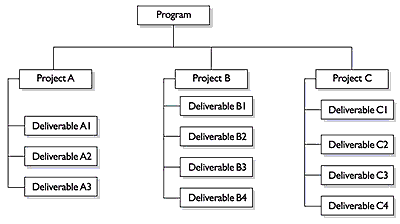
Introduction
Inhalte von Prof. Dr. Kurt Englmeier
Overview
- Lecture and tutorials will be held in English
- Exams (written): German or English (Spanish on request)
- Literature: ISBN-13: 978-0-07-162673-6
Tutorial
- Software: OpenProj (http://www.serena.com/products/openproj/)
- Literature: ISBN-13: 978-1-59863-817-2
Content
- Introduction to Project Management
- Project Life Cycle
- Project Management Process
- Project Implementation
- Managing Project Scope
- Cost Management
- Quality Management
- Human Resource Management
- Communication Management
- Risk Management
- Project Procurement
Introduction
- Projects are endeavors.
- Projects are temporary.
- Projects Create Unique Products, Services, or Results
Projects Create Unique Products, Services, or Results
This one isn't tough to figure out. Projects have to create a thing, invent a service, or change an environment. The deliverable of the project—a successful project, that is—satisfies the scope that was created way, way back when the project got moving. Projects create the following:
- Things:Projects can create a thing such as a skyscraper, which is the end of the project. Or projects can create components that contribute to other projects or things, such as a project to install all of the glass windows in a skyscraper.
- Services: A project creating a service could establish a new call center, an order fulfillment process, or a faster way to complete inventory audits.
- Results: Projects can be research-driven. Consider a research-and-development project with a pharmaceutical company to find a cure for the common cold.
Projects are unique. This means that every project you ever do is different from all the other projects you've done in the past. Even if it's the same basic approach to get to the same end result, there are unique factors within each project, such as the time it takes, the stakeholders involved, the environment the project takes place in, and on and on the uniqueness goes. Basically, all projects are unique, even if your company does the same type of project repeatedly.
Progressive Elaboration
All projects begin as a concept. A project concept to create a new product or service typically includes a broad vision of what the end result of the project will be. The temporary project results in the unique product or service through progressive elaboration. Progressive elaboration is simply developing in steps and continuing by increments.
As a project moves closer to completion, the identified needs that launched the project are revisited and monitored. Complete understanding of the needs—and the ability to fulfill those needs—comes from progressive elaboration.

Projects vs. Operations
Jane is a project manager for her organization. Vice presidents, directors, and managers with requests to investigate or to launch potential projects approach her daily—or so it seems to Jane. Just this morning, the sales manager met with Jane because he wants to implement a new direct-mail campaign to all of the customers in the sales database. He wants this direct-mail campaign to invite customers to visit the company website to see the new line of products. Part of the project also requires that the company website be updated so that it's in sync with the mailing. Sounds like a project, but is it really? Could this actually be just a facet of an ongoing operation?
In some organizations, everything is a project. In other organizations, projects are rare exercises in change. There's a fine line between projects and operations, and often, these separate entities overlap in function. Consider the following points shared by projects and operations:
- Both involve employees
- Both typically have limited resources: people, money, or both
- Both are hopefully designed, executed, and managed by someone in charge
In the preceding example, Jane has been asked to manage a direct-mail campaign to all of the customers in the sales database. Could this be a project? Sure—if this company has never completed a similar task and there are no internal departments that do this type of work as part of their regular activities. Often, projects are confused with general business duties: marketing, sales, manufacturing, and so on.
Some examples of projects include
- Designing a new product or service
- Converting from one computer application to another
- Building a new warehouse
- Moving from one building to another
- Organizing a political campaign
- Designing and building a new airplane
Reasons why a project is created:
- Opportunity: Your company is growing so quickly that a project is launched to create a sales-and order-fulfillment application.
- Problems: All of the computers are older than Moses, so a project is launched to replace all of the computers and standardize office applications.
- Customers: Many organizations, such as IT integrators, construction companies, architects, and dozens more, complete projects for other people. Customers drive new projects.
- Technology: Technology changes so quickly that there are constantly new technical projects within an organization.
- Lawyers: Laws can cause a new project to launch. Consider the recent Sarbanes-Oxley requirements, for example. This new law spurred many projects to adhere to the new privacy requirements. Laws and regulations within different industries can also spur new projects—consider pharmaceutical, insurance, health care, and on and on. Regulations are required, but standards are guidelines.
Definition
Project management is the supervision and control of the work required to complete the project vision. The project team carries out the work needed to complete the project, while the project manager schedules, monitors, and controls the various project tasks. Projects, being the temporary and unique things that they are, require the project manager to be actively involved with the project implementation. They are not self-propelled.
Project Integration Management
Project integration management This knowledge area focuses on creating the project charter, the project scope statement, and a viable project plan. Once the project is in motion, project integration management is all about monitoring and controlling the work. If changes happen, and we know they will, you have to determine how that change may affect all of the other knowledge areas.
Project Scope Management
Project scope management This knowledge area deals with the planning, creation, protection, and fulfillment of the project scope. One of the most important activities in all of project management happens in this knowledge area: creation of the work breakdown structure.
Project Time Management
Project time management Time management is crucial to project success. This knowledge area covers activities, their characteristics, and how they fit into the project schedule. This is where you and the project team will define the activities, plot out their sequence, and calculate how long the project duration will actually take.
Project Cost Management
Project cost management Cost is always a constraint in project management. This knowledge area is concerned with the planning, estimating, budgeting, and control of costs. Cost management is tied to time and quality management—screw either of these up and the project costs will increase.
Project Quality Management
Project quality management What good is a project that's done on time if the scope isn't complete, the work is faulty, or the deliverable is horrible? Well, it's no good. This knowledge area centers on quality planning, assurance, and control.
Project Human Resource Management
Project human resource management This knowledge area focuses on organizational planning, staff acquisition, and team development. You have to somehow acquire your project team, develop this team, and then lead them to the project results.
Project Communications Management
Project communications management Ninety percent of a project manager's time is spent communicating. This knowledge area details how communication happens, outlines stakeholder management, and shows how to plan for communications within any project.
Project Risk Management
Project risk management Every project has risks. This knowledge area focuses on risk planning, analysis, monitoring, and control. You'll have to complete qualitative analysis and then quantitative analysis in order to adequately prepare for project risks. Once the project moves forward, you'll need to monitor and react to identified risks as planned.
Project Procurement Management
Project procurement management Projects often need things and services in order to reach closing. This knowledge area covers the business of project procurement, the processes to acquire and select vendors, and contract negotiation. The contract between the vendor and the project manager's organization will guide all interaction between the project manager and the vendor.
Programm Management

Project Portfolio Management
Often, projects are lumped into a portfolio rather than into a program. A program is a collection of projects that work together for a common cause. For example, a program could be a collection of projects to build a skyscraper. A portfolio describes the collection of investments in the form of projects and programs in which the organization invests capital. The project manager and, if applicable, the program manager report to a portfolio review board on the performance of the projects and programs. The portfolio review board may also direct the selection of projects and programs.
Project Management Office
A project management office (PMO) organizes and manages control over all projects within an organization. A PMO is also known as a program management office, project office, or simply the program office.
PMOs usually coordinate all aspects, methodology, and nomenclature for project processes, templates, software, and resource assignment. Ideally, a PMO creates a uniform approach within an organization so that all projects, regardless of their discipline, technology, or purpose, are managed with the same approach.
CategoryProjectIntegrationManagement
Diese Seite wurde noch nicht kommentiert.





